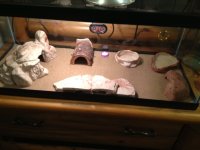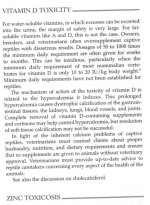Just in case, Michael:
http://www.geckosunlimited.com/comm...-feeding-issues/68574-cricket-guidelines.html
Cricket Guidelines
Hassle-free Cricket Care
ElizabethFreer@aol.com
Geckos Unlimited/Pacific Northwest Herpetological Society
13 May 2013 (amended)
(
www.GeckosUnlimited.com)
Take a suitably sized container, for instance, an extra large Kritter Keeper or a 56 quart Sterilite bin. Place a good quality all purpose poultry feed (Albers All Purpose Purpose Poultry Feed), dry oatmeal, and alfalfa hay on the bottom of the cage. Add your crickets. Next cover with a double layer of egg cartons. On top of the egg cartons place a paper towel. Spray the paper towel generously every other day. Keep crickets between 70 F and the mid 80s. They will grow faster if warmer, but seem to do fine at 70 F. If room temperatures exceed 85 F spray the paper towel daily.
Spraying the paper towel is an excellent way to provide moisture for your crickets and save them from perishing from too much moisture.
Feed crickets an All Purpose Poultry Feed (contains about 16% protein, 3% fat, & vitamin A acetate), dry oatmeal, alfalfa hay (“Hay-Kob”: 800-332-5623), collard greens, and carrots. General Mills' dry cereal whole grain TOTAL can be used in a pinch.
If your source is pesticide-free with good soil, dandelion flowers and greens can also be fed to the crickets. To make the alfalfa hay easy to chew for young crickets, soak the alfalfa hay in water prior to adding .
Do not feed insects puppy, kitten, dog, and/or cat biscuits/food OR tropical fish flakes. Those are way too high in protein and fat and potentially could cause hepatic lipidosis (fatty liver disease).
Do not feed dead/canned crickets to your geckos. Any gecko gets moisture from well-hydrated prey as well as the nutrients such prey provides.
By following these recommendations it is quite easy to keep your crickets alive and thriving easily one to two months past purchase.
Formally "gutload" crickets 48 hours prior to feeding off to geckos with T-REX Calcium Plus Food for Crickets.
Gutloading the Feeders versus Feeding the Feeders 24/7
The term gutloading causes some confusion. Feed your feeders a nutritious regular diet all the time to build strong feeder bodies. Then only feed a special GUTLOAD product to the crickets, for example, 1-2 days prior to feeding the crickets to your geckos. T-REX Calcium Plus Cricket Food is a good gutload food. Top off the crickets by lightly dusting with a multivitamin containing D3/vitamin A acetate and phosphorus-free calcium with D3 no more than 2x weekly.
2 March 2013:
Captured directly from Hilde's post #134, 27 Feb 2013, on "spoiled by crickets" thread in the crestie forum:
"If you feed the insects a decent diet full time, not just a day before feeding them off, you really improve the nutrients they'll provide - build a better body, not just fill the relatively short intestinal tract."
Last edited by Elizabeth Freer; 05-14-2013 at 10:35 AM.



